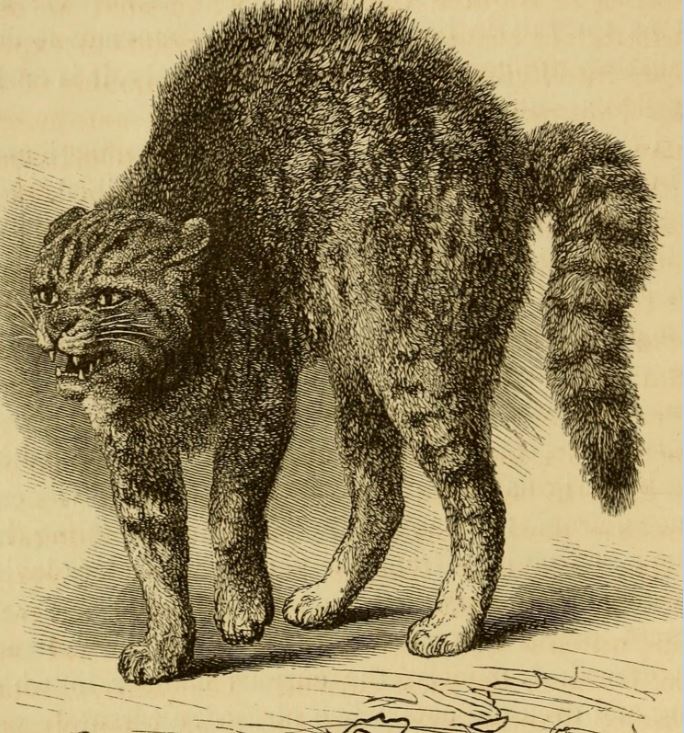Willett’s Bewitched Cat

Willett’s Bewitched Cat
While looking into the question of bewitched cows (as one does), I found a case of a “bewitched cat,” which at first suggested witchcraft, but, as this snappy headline reveals, seems to have been more a half-baked idea about the transmigration of souls.
Is the Murderer’s Spirit in the Cat?
Kingston, N.Y., Jan. 23. Louis Willett was executed in this city last May for the murder of Edward Kelland. Shortly after sentence had been passed on the condemned man, he was presented with a little kitten, to which he became closely attached. Willett taught his little companion many tricks. They ate off the same dish, and slept together at night. For twenty-four hours previous to Willett’s execution the kitten refused to leave the prisoner’s lap. When placed on the floor, it would cling to Willett’s trousers and cry pitifully to be taken up again in his arms. The morning of the execution, the kitten took up its position on the steps of the staircase where Kelland’s slayer was hanged, and it remained there during the entire proceedings.
Later in the day the faithful kitten was found cuddled up in his late master’s bed. Food was ordered again and again, but the kitten refused to eat, and went mewing pitifully about the prison. The kitten has long since grown to be a cat. “Willett’s bewitched cat,” the superstitious prisoners call it. When a fresh prisoner arrives in the jail and inquiries about Willett’s cell and the place where he stood when executed, the cat is said to stare at the questioner and its hair raises on end until it seems to have grown double its normal size. The tail of the cat becomes enormous, ‘swelling out like plumes of a hearse,’ one of the prisoners said, while it snaps and acts like a veritable fury. Its eyes are like great balls of green fire, and it flies back and forth through the corridors of the jail to the terror of the prisoners, young and old. The cat is quiet and inoffensive at times, but, as one of the prisoners said yesterday, “There’s no tellin’ when it will fly at one or get one of its spells.”
The daintiest morsels of the prisoners’ food are given to the cat and all the inmates of the jail treat it with the utmost consideration. “Kill it!” said one of the prisoners the other day. “Why, all the money in Kingston city wouldn’t induce a man here to kill that cat. Willett’s ghost would haunt us and we’d never do another day’s good or harm.”
The Salt Lake [UT] Herald 19 February 1887: p. 2
Another headline for this story reads
THIS IS THE PREMIUM CAT YARN.
A Grimalkin of Most Uncanny Nature Unearthed in Kingston.
Patriot [Harrisburg, PA] 24 January 1887: p. 1
Put “Yarn” and “Grimalkin” in the same heading and you’ve got the usual anti-superstition snark about witches and their cats so familiar to the Pennsylvanian press.
Willett, described by one paper as a “repulsive-looking young man,” seems to have almost gotten away with murdering his employer, a saloon-keeper (sometimes genteelly described as a restaurateur.) The murder took place on the 7th of January, 1884. Willett fled and was not arrested until the following July; he’d spent time berry-picking and working on farms in Ulster County, New York, eventually ending up in New York City. Willett confessed, but said the murder was done in the heat of passion after a quarrel with his employer. This was probably wishful thinking; Willett stole a heavy brass beer faucet weeks before using it to bash in Kelland’s skull.
A diverting element of the trial was the testimony of witnesses who reported that Willett had an “unhealthy” obsession with trashy newspapers and dime-novels. One journalist claimed to have found Willett’s diary where he described in blood-and-thunder style, the crimes he would like to commit. Willett was executed with very little fuss, except for the cat’s distress, on 21 May 1886. [Source: Murder & Mayhem in Ulster County, A.J. Schenkman, Elizabeth Werlau]
Unless some of the prison visitors were Theosophists, passing out tracts on metempsychosis, we must doubt that the inmates of the Ulster County Jail really thought that Willett’s enraged spirit (he was known for his bad temper) was possessing the cat. Blame it on the headline writer. The whole story seems to fall more into the “dog refuses to leave master’s grave” genre. (Given the independent nature of cats and the fact that they were always being caught trying to eat corpses at wakes, is there even an remotely equivalent feline genre?) Perhaps the best we can say about the “bewitched cat” was that the other prisoners considered the creature to be Willett’s familiar and believed the dead man would haunt them if Grimalkin wasn’t treated properly.
Any other stories of the cat and its ultimate fate? I haven’t found any reports of Willett haunting the jail so perhaps it happily lived out its nine lives. chriswoodyard8 AT gmail.com
Chris Woodyard is the author of The Victorian Book of the Dead, The Ghost Wore Black, The Headless Horror, The Face in the Window, and the 7-volume Haunted Ohio series. She is also the chronicler of the adventures of that amiable murderess Mrs Daffodil in A Spot of Bother: Four Macabre Tales. The books are available in paperback and for Kindle. Indexes and fact sheets for all of these books may be found by searching hauntedohiobooks.com. Join her on FB at Haunted Ohio by Chris Woodyard or The Victorian Book of the Dead. And visit her new blog at The Victorian Book of the Dead.
